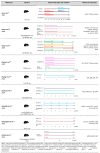Biological Activity of c-Peptide in Microvascular Complications of Type 1 Diabetes-Time for Translational Studies or Back to the Basics?
- PMID: 33419247
- PMCID: PMC7766542
- DOI: 10.3390/ijms21249723
Biological Activity of c-Peptide in Microvascular Complications of Type 1 Diabetes-Time for Translational Studies or Back to the Basics?
Abstract
People with type 1 diabetes have an increased risk of developing microvascular complications, which have a negative impact on the quality of life and reduce life expectancy. Numerous studies in animals with experimental diabetes show that c-peptide supplementation exerts beneficial effects on diabetes-induced damage in peripheral nerves and kidneys. There is substantial evidence that c-peptide counteracts the detrimental changes caused by hyperglycemia at the cellular level, such as decreased activation of endothelial nitric oxide synthase and sodium potassium ATPase, and increase in formation of pro-inflammatory molecules mediated by nuclear factor kappa-light-chain-enhancer of activated B cells: cytokines, chemokines, cell adhesion molecules, vascular endothelial growth factor, and transforming growth factor beta. However, despite positive results from cell and animal studies, no successful c-peptide replacement therapies have been developed so far. Therefore, it is important to improve our understanding of the impact of c-peptide on the pathophysiology of microvascular complications to develop novel c-peptide-based treatments. This article aims to review current knowledge on the impact of c-peptide on diabetic neuro- and nephropathy and to evaluate its potential therapeutic role.
Keywords: c-peptide; diabetes; diabetes-associated complications; nephropathy; neuropathy.
Conflict of interest statement
The authors declare no conflict of interest.
Figures





Similar articles
-
C-peptide as a therapeutic tool in diabetic nephropathy.Am J Nephrol. 2010;31(5):389-97. doi: 10.1159/000289864. Epub 2010 Mar 31. Am J Nephrol. 2010. PMID: 20357430 Review.
-
Protective effect of C-peptide on experimentally induced diabetic nephropathy and the possible link between C-peptide and nitric oxide.Appl Physiol Nutr Metab. 2018 Jun;43(6):617-624. doi: 10.1139/apnm-2017-0617. Epub 2018 Jan 19. Appl Physiol Nutr Metab. 2018. PMID: 29351386
-
Diabetic neuropathy in type 1 and type 2 diabetes and the effects of C-peptide.J Neurol Sci. 2004 May 15;220(1-2):133-6. doi: 10.1016/j.jns.2004.03.014. J Neurol Sci. 2004. PMID: 15140622 Review. No abstract available.
-
C-peptide, Na+,K(+)-ATPase, and diabetes.Exp Diabesity Res. 2004 Jan-Mar;5(1):37-50. doi: 10.1080/15438600490424514. Exp Diabesity Res. 2004. PMID: 15198370 Free PMC article. Review.
-
Cellular and physiological effects of C-peptide.Clin Sci (Lond). 2009 Apr;116(7):565-74. doi: 10.1042/CS20080441. Clin Sci (Lond). 2009. PMID: 19243312 Review.
Cited by
-
The Impact of C-Peptide and Diabetes Mellitus on Coronary Ectasia and Effect of Coronary Ectasia and C-Peptide on Long-Term Outcomes: A Retrospective Cohort Study.Int J Clin Pract. 2022 Oct 8;2022:7910566. doi: 10.1155/2022/7910566. eCollection 2022. Int J Clin Pract. 2022. PMID: 36277470 Free PMC article.
-
Impact of Fat Distribution and Metabolic Diseases on Cerebral Microcirculation: A Multimodal Study on Type 2 Diabetic and Obese Patients.J Clin Med. 2024 May 14;13(10):2900. doi: 10.3390/jcm13102900. J Clin Med. 2024. PMID: 38792441 Free PMC article.
-
C-peptide and residual β-cell function in pediatric diabetes - state of the art.Pediatr Endocrinol Diabetes Metab. 2021;27(2):123-133. doi: 10.5114/pedm.2021.107165. Pediatr Endocrinol Diabetes Metab. 2021. PMID: 34514768 Free PMC article. Review.
-
Epigenetics and Beyond: Targeting Histone Methylation to Treat Type 2 Diabetes Mellitus.Front Pharmacol. 2022 Jan 11;12:807413. doi: 10.3389/fphar.2021.807413. eCollection 2021. Front Pharmacol. 2022. PMID: 35087408 Free PMC article. Review.
-
Research Progress of Bioactive Peptides in Improving Type II Diabetes.Foods. 2025 Jan 21;14(3):340. doi: 10.3390/foods14030340. Foods. 2025. PMID: 39941934 Free PMC article. Review.
References
Publication types
MeSH terms
Substances
LinkOut - more resources
Full Text Sources
Medical

